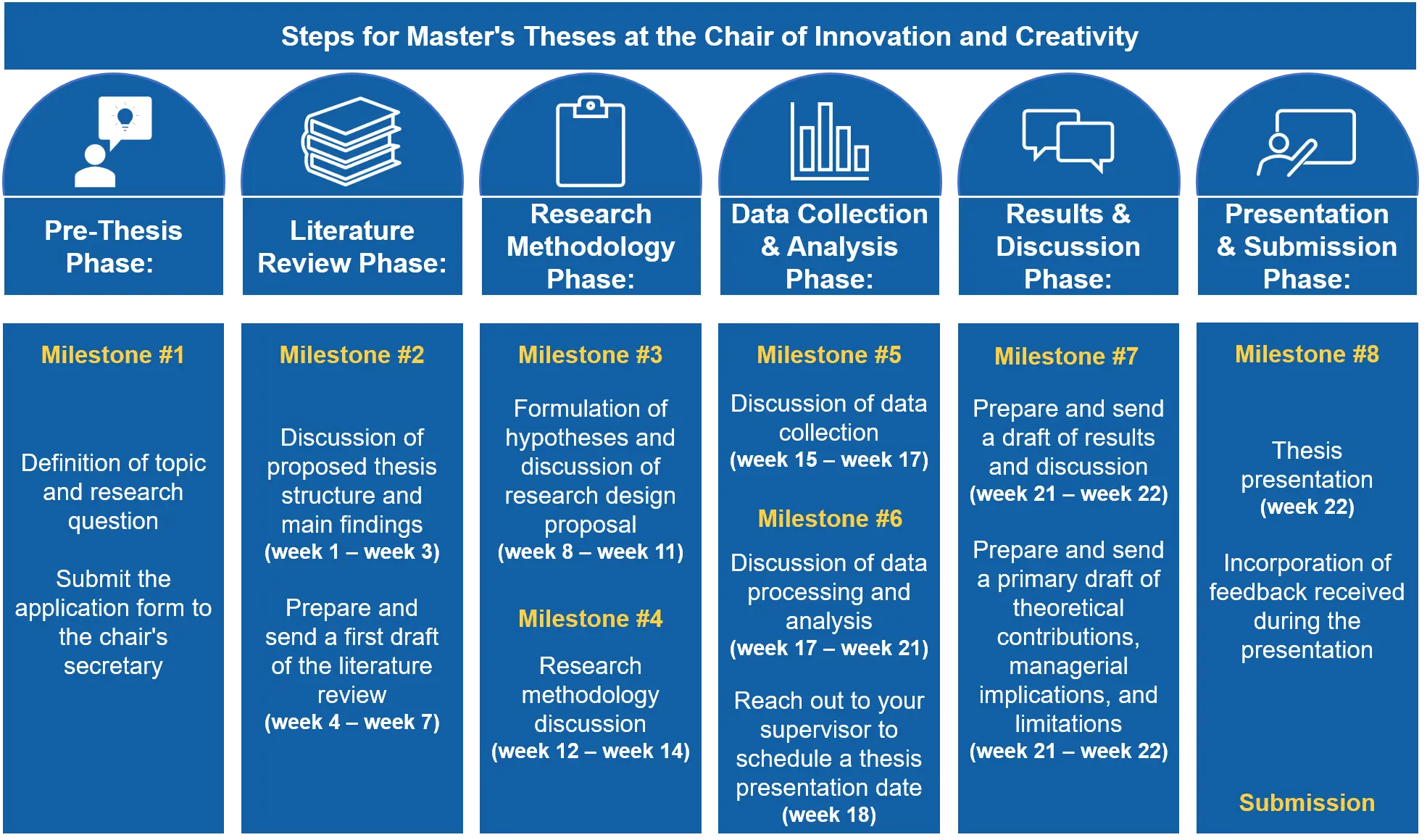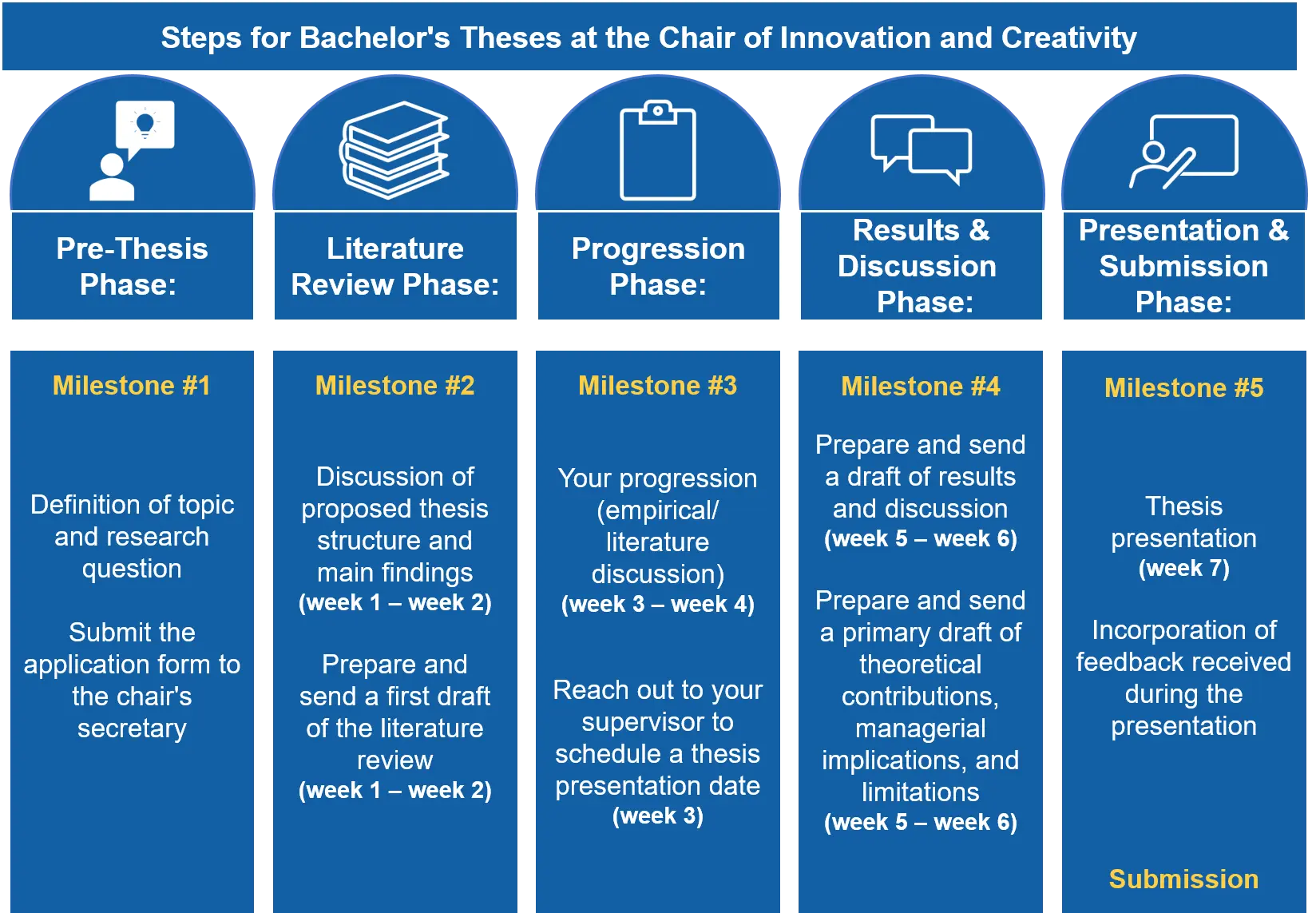Bachelor & Master Theses
We support a variety of research topics and approaches for student theses at the Chair of Innovation and Creativity. We supervise academic research, as well as applied research in cooperation with companies or other industry partners. We invite Master’s and Bachelor’s students to explore exciting and innovative Thesis Topics at our chair across multiple areas, including Marketing, Innovation Management, Sustainability, Creativity, Consumer Psychology, Managerial Decision Making, and topics regarding Health and Well-being. You can find a list of Sample Thesis Topics below. We supervise multiple research methods, including conceptual research with systematic literature reviews, surveys, experimental research, datasets, big data analysis, qualitative research (e.g., interviews), and case studies.
Bachelor Theses can be Literature Reviews and, in some cases, can include case studies, interviews, or quantitative research.
Master Theses have to include primary data collection, such as interviews, surveys, or experiments.
We will evaluate your application based on the items mentioned in the application form and decide based on our capacities if we will be able to supervise you.
Click Here for Thesis Application Process
Click Here for Thesis Guidelines
Please Note Before Applying
- Students who wish to write their thesis at the chair of Innovation and Creativity should have completed (or be currently enrolled in) at least one class offered by the chair.
- Bachelor students who wish to apply are required to have successfully completed their “Proseminar.”
- The completed Application Form, CV, and Email should all be in English and sent to thesis.matta(at)ku.de.
- It is never too early to apply; Given our capacity planning at the chair, we encourage you to apply early.
- We invite you to read the Thesis Structure and Timeline section right below, to understand the thesis process at our chair.
Sample Thesis Topics Offered at Our Chair
1. Well-Being of Consumers or Employees: Subjective Well-Being / Physical Well-Being / Financial Well-Being of Consumers or Employees in an Organization
Examples of Thesis Topics:
- Employees’ Well-Being Interventions in Organizations
- Improving Consumers’ Financial Well-Being
- How Can Consumption Improve Consumer Well-Being?
Helpful Literature:
Brüggen, E. C., Hogreve, J., Holmlund, M., Kabadayi, S., & Löfgren, M. (2017). Financial well-being: A conceptualization and research agenda. Journal of Business Research, 79, 228-237.
Devezer, B., Sprott, D. E., Spangenberg, E. R., & Czellar, S. (2014). Consumer well-being: Effects of subgoal failures and goal importance. Journal of Marketing, 78(2), 118-134.
Diener, E. (1984). Subjective well-being. Psychological Bulletin, 95(3), 542.
Mende, M., & Van Doorn, J. (2015). Coproduction of transformative services as a pathway to improved consumer well-being: Findings from a longitudinal study on financial counseling. Journal of Service Research, 18(3), 351-368.
Netemeyer, R. G., Warmath, D., Fernandes, D., & Lynch Jr, J. G. (2018). How am I doing? Perceived financial well-being, its potential antecedents, and its relation to overall well-being. Journal of Consumer Research, 45(1), 68-89.
Page, K. M., & Vella-Brodrick, D. A. (2009). The ‘what’,‘why’and ‘how’of employee well-being: A new model. Social Indicators Research, 90, 441-458.
2. Gender Identity / Social Identity / Stereotypes: In Consumer Behavior and in Organizations
Examples of Thesis Topics:
-
Marketing for Stigmatized Consumers
-
The Effect of Identity Threats on Consumer Behavior
-
Gender Stereotyping of Brands / Service Providers / Employees: Implications for Organizations
Helpful Literature:
Branscombe, N. R., Ellemers, N., Spears, R., & Doosje, B. (1999). The context and content of social identity threat. Social identity: Context, commitment, content, 35-58.
Brescoll, V. L. (2016). Leading with their hearts? How gender stereotypes of emotion lead to biased evaluations of female leaders. The Leadership Quarterly, 27(3), 415-428.
Chaney, K. E., Sanchez, D. T., & Maimon, M. R. (2019). Stigmatized‐identity cues in consumer spaces. Journal of Consumer Psychology, 29(1), 130-141.
Reed II, A., Forehand, M. R., Puntoni, S., & Warlop, L. (2012). Identity-based consumer behavior. International Journal of Research in Marketing, 29(4), 310-321.
Rogova, N., & Matta, S. (2022). The role of identity in digital consumer behavior: A conceptual model and research propositions based on gender. AMS Review, 1-16.
Wooten, D., & Rank‐Christman, T. (2019). Stigmatized‐identity cues: Threats as opportunities for consumer psychology. Journal of Consumer Psychology, 29(1), 142-151.
3. Digital Customer Experience / Online Word-of-Mouth / Social Influence in Social Media
Examples of Thesis Topics:
- The Influence of Social Messages in Online Social Networks
- Identity-based Online Word-of-Mouth
- The Role of Social Media Marketing in Digital Customer Experience
Helpful Literature:
Alves, H., Fernandes, C., & Raposo, M. (2016). Social media marketing: a literature review and implications. Psychology & Marketing, 33(12), 1029-1038.
Appel, G., Grewal, L., Hadi, R., & Stephen, A. T. (2020). The future of social media in marketing. Journal of the Academy of Marketing science, 48(1), 79-95.
Argo, J. J. (2020). A contemporary review of three types of social influence in consumer psychology. Consumer Psychology Review, 3(1), 126-140.
Grewal, L., & Stephen, A. T. (2019). Identity in the digital age. In A. Reed II, & M. Forehand (Eds.), Handbook of research on identity theory in marketing (pp. 388–403). Edward Elgar Publishing.
Rogova, N., & Matta, S. (2022). The role of identity in digital consumer behavior: A conceptual model and research propositions based on gender. AMS Review, 1-16.
Stephen, A. T. (2016). The role of digital and social media marketing in consumer behavior. Current opinión in Psychology, 10, 17-21.
4. Innovation and Growth Strategies in Small and Mid-Sized Companies
Examples of Thesis Topics:
-
Investigating the Role of Digitalization in Small and Medium-sized Companies’ Growth Strategies
-
Investigating the Role of Sustainability in Small and Medium-sized Companies’ Growth Strategies
-
Innovation Strategies for SMEs
Helpful Literature:
Audretsch, D. B., Coad, A. & Segarra, A. (2014). Firm growth and innovation. Small Business Economics, 43(4), 743–749.
Karlsson, C. & Tavassoli, S. (2016). Innovation strategies of firms: What strategies and why? Journal of Technology Transfer, 41(6), 1483–1506.
Terziovski, M. (2010). Innovation practice and its performance implications in small and medium enterprises (SMEs) in the manufacturing sector: a resource-based view. Strategic Management Journal, 31(8), 892–902.
5. Open Innovation / Co-created Innovation
Examples of Thesis Topics:
- Open Innovation Approaches in SMEs: Effects on Innovation Performance
- B2B Open Innovation: Implications and Measures
- Effective Co-Creation and Open Innovation Ecosystems
Helpful Literature:
Alam, Muhammad Aftab, David Rooney, and Murray Taylor (2022), “From Ego‐Systems to Open Innovation Ecosystems: A Process Model of Inter‐Firm Openness,” Journal of Product Innovation Management, 39 (2), 177–201.
Bogers, Marcel, Ann-Kristin Zobel, Allan Afuah, Esteve Almirall, Sabine Brunswicker, Linus Dahlander, Lars Frederiksen, Annabelle Gawer, Marc Gruber, Stefan Haefliger, John Hagedoorn, Dennis Hilgers, Keld Laursen, Mats G. Magnusson, Ann Majchrzak, Ian P. McCarthy, Kathrin M. Moeslein, Satish Nambisan, Frank T. Piller, Agnieszka Radziwon, Cristina Rossi-Lamastra, Jonathan Sims, and Anne L. J. Ter Wal (2017), “The Open Innovation Research Landscape: Established Perspectives and Emerging Themes across Different Levels of Analysis,” in Industry and Innovation, 8–40.
Chesbrough, Henry William (2003), Open Innovation: The New Imperative for Creating and Profiting from Technology, Boston, Mass.: Harvard Business School Press.
Hossain, Mokter and Ilkka Kauranen (2016), “Open Innovation in SMEs: A Systematic Literature Review,” Journal of Strategy and Management, 9 (1), 58–73.
Markovic, Stefan, Mehdi Bagherzadeh, Wim Vanhaverbeke, and Marcel Bogers (2021), “Managing Business-to-Business Open Innovation: A Project-level Approach,” Industrial Marketing Management, 94, 159–163.
Piller, Frank T., Christoph Ihl, and Alexander Vossen (2010), “A Typology of Customer Co-Creation in the Innovation Process,” SSRN Electronic Journal.
6. Branding / Brand Extensions / Brand Equity / Employer Branding
Examples of Thesis Topics:
-
The Role of Sustainability in Branding
-
Investigating the Relationship between Brand Equity and Sustainability
-
The Role of Employer Branding in attracting Generation Z Talents
Helpful Literature:
Biswas, M. K. & Suar, D. (2016). Antecedents and Consequences of Employer Branding. Journal of Business Ethics, 136 (1), 57–72.
Keller, K. L. (1993). Conceptualizing, Measuring, and Managing Customer-Based Brand Equity. Journal of Marketing, 57 (1).
Olsen, M. C., Slotegraaf, R. J. & Chandukala, S. R. (2014). Green Claims and Message Frames: How Green New Products Change Brand Attitude. Journal of Marketing, 78 (5), 119–137.
Theurer, C. P., Tumasjan, A., Welpe, I. M. & Lievens, F. (2018). Employer Branding: A Brand Equity-based Literature Review and Research Agenda. International Journal of Management Reviews, 20 (1), 155–179.
Yoo, B., Donthu, N. & Lee, S. (2000). An Examination of Selected Marketing Mix Elements and Brand Equity. Journal of the Academy of Marketing Science, 28 (2), 195–211.
7. Consumers’ / Employees' Privacy and its effect on Behavior
Examples of Thesis Topics:
- Privacy Literacy and its Effect on Consumer Behavior
- The Role of AI in shaping Consumer Behavior or Employee Behavior
- The Role of Consumers’ Privacy on Marketplace Behavior
- The Role of Employees' Privacy on Behavior in Organizations
Helpful Literature:
Abrardi, Laura, Carlo Cambini, and Laura Rondi (2022), “Artificial intelligence, firms and consumer behavior: A survey,” Journal of Economic Surveys, 36 (4), 969-991.
Alzaidi, Maram Saeed and Gomaa Agag (2022), “The role of trust and privacy concerns in using social media for e-retail services: The moderating role of COVID-19,” Journal of Retailing and Consumer Services, 68.
Martin, Kelly D., Abhishek Borah, and Robert W. Palmatier (2017), “Data Privacy: Effects on Customer and Firm Performance,” Journal of Marketing, 81 (1), 36–58.
Scarpi, Daniele, Gabriele Pizzi, and Shashi Matta (2022), “Digital Technologies and Privacy: State of the Art and Research Directions,” Psychology and Marketing, 39 (9), 1687-1697.
8. Social and Economic Inequality and its Influence on Consumer Behavior, or on Employee Bahavior
9. Behavioral Research with Consumers or Employees: Consumer Psychology and Behavior including Nudging; Employee Psychology and Behavior including Nudging
10. The Science of Happiness: Happiness in Life, Work, and Consumption
Thesis Structure and Timeline
A typical thesis at our chair has the following structure for general timeline and touch points. Please keep in mind that each thesis is unique and might vary from the typical structure as needed.
Master's Thesis Timeline

Bachelor's Thesis Timeline
